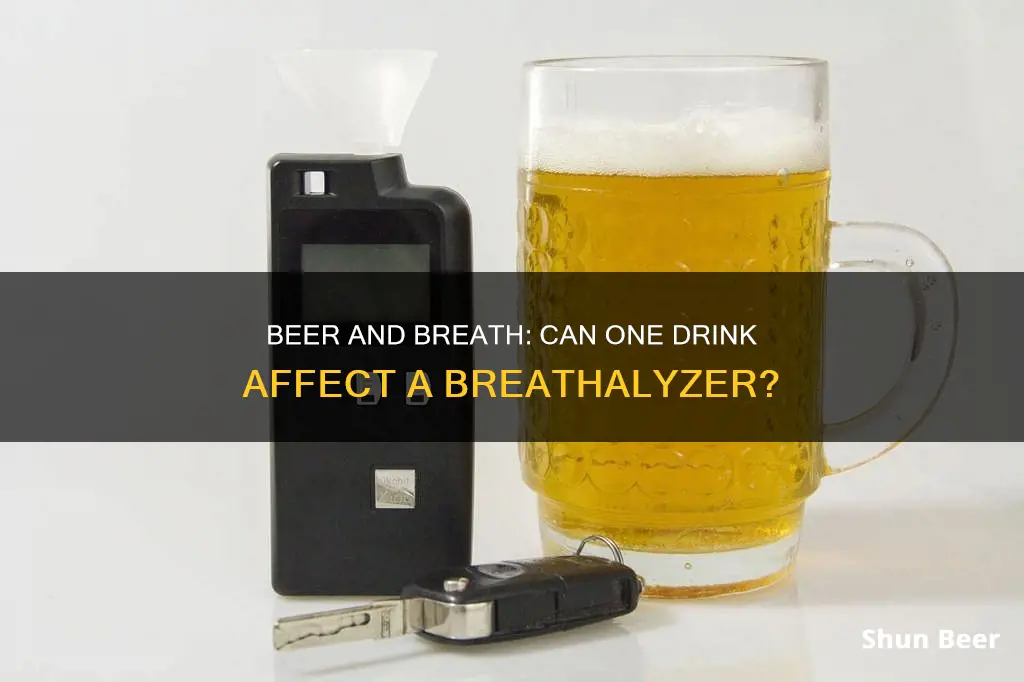
Whether or not you can blow a 0.08 Blood Alcohol Concentration (BAC) level after drinking one beer depends on a variety of factors. These include your body weight, the amount of food you've eaten, the type of beer and its alcohol content, and your metabolic rate. Generally, it is estimated that it takes around four to five standard drinks (12-ounce beers) over two hours for men of average size and weight to reach a 0.08 BAC level, and around three to four standard drinks for women of average size and weight. However, it's important to note that these are just approximations and can vary widely depending on individual factors. The most important factor influencing BAC is body weight, with heavier individuals requiring more drinks to reach the legal limit.
What You'll Learn

Gender differences in blood alcohol concentration (BAC)
The amount of alcohol that leads to a blood alcohol concentration (BAC) of 0.08% varies from person to person. Factors such as body weight, food intake, type of alcohol, and rate of consumption all influence BAC. As a result, there is no precise answer to how many drinks it takes to reach a BAC of 0.08%. However, as a general guideline, it is estimated that for men of average size and weight, consuming four to five standard drinks over two hours can result in a BAC of 0.08%. This is one more drink than women of average size and weight, who typically reach the same BAC by consuming three to four standard drinks over two hours.
Men and women of below-average size and weight would require fewer drinks to reach a BAC of 0.08%, while heavier individuals would require more drinks. However, the most critical factor influencing BAC is body weight. Individuals with higher body weight or a larger body size have a higher blood volume, which dilutes the alcohol and results in a lower BAC compared to those with less body weight.
In addition to body weight, gender differences in body composition, water content, and alcohol metabolism also contribute to variations in BAC between men and women. Women often experience higher BAC levels than men, even when consuming the same number of drinks and being the same size and weight. This is due to differences in body composition, water content, and the rate at which alcohol is metabolized. Men tend to metabolize alcohol faster because they have higher levels of an enzyme called alcohol dehydrogenase (ADH) in their stomach and liver.
It is important to note that the effects of alcohol can vary significantly even among individuals of the same gender, size, and weight. Factors such as metabolism, health, medications, and drinking habits can influence how alcohol is processed by the body. Additionally, the rate at which alcohol is consumed plays a crucial role, as drinking alcohol rapidly will spike BAC levels more quickly than consuming drinks slowly over an extended period. Therefore, while general guidelines can provide estimates, the specific effects of alcohol on an individual's BAC can vary widely.
Drinking Beer on a Pier: What's the Legal Ruling?
You may want to see also

Weight and height influence on BAC
Weight and height influence a person's BAC, or Blood Alcohol Content. BAC is a measure of the alcohol in a person's bloodstream, expressed as a percentage. For example, a BAC of 0.1 means that one-tenth of one percent of a person's blood is alcohol. The higher the BAC, the more alcohol is in a person's bloodstream.
Several factors influence BAC, including weight, height, gender, metabolic rate, and food consumption. Generally, heavier people can consume more alcohol before reaching the same BAC as lighter people. For example, a person weighing 100 lbs would need three drinks in an hour to reach a BAC of 0.08, while a person weighing 220 lbs would need six drinks in an hour. Similarly, men tend to have a higher BAC tolerance than women, with men typically being able to consume around four drinks before reaching a BAC of 0.08, while women can only have around 2.5 drinks. However, it's important to note that these are general estimates and can vary depending on other factors.
Height can also play a role in BAC levels, as body mass and distribution can affect how alcohol is absorbed and metabolized. Taller people tend to have a higher body mass and may have a higher tolerance for alcohol. However, height alone is not a direct indicator of BAC, as other factors such as muscle mass and body composition also play a role. Additionally, height and weight biases have been observed in self-reported data, with people overestimating their height and underreporting their weight, which can affect the accuracy of BAC calculations.
Overall, weight and height are important factors in determining BAC levels, but they are not the only factors. Other factors, such as metabolic rate, gender, and food consumption, can also have a significant impact on BAC levels. Understanding how these factors interact is crucial for staying safe and making informed decisions about alcohol consumption.
Beer and Guaifenesin: Mixing Alcohol and Cough Medicine
You may want to see also

Alcohol metabolism rates
Firstly, the liver can only metabolise alcohol at a certain rate. It takes, on average, around one hour for the liver to process one standard drink. This rate is determined by the liver's ability to produce the enzyme alcohol dehydrogenase, which breaks alcohol down into ketones. This rate is relatively constant and cannot be sped up. Therefore, if alcohol is consumed faster than the liver can process it, the excess alcohol will continue to circulate in the bloodstream, leading to intoxication.
Secondly, the rate at which alcohol is absorbed into the bloodstream also affects metabolism rates. About 20% of alcohol is absorbed through the stomach, and the remaining 80% through the small intestine. The presence of food in the stomach slows the absorption of alcohol, as it physically obstructs the alcohol from coming into contact with the stomach lining, and prevents it from passing into the upper portion of the small intestine. Greasy, high-protein, and fatty foods are particularly effective at slowing absorption, as they take longer to digest.
Thirdly, body composition also plays a role in alcohol metabolism rates. Since alcohol can penetrate about 68% of body tissues in adult males, individuals with a higher percentage of body fat will have a lower volume of distribution for alcohol, resulting in higher peak blood alcohol levels. Women generally have a smaller volume of distribution for alcohol than men due to their higher percentage of body fat. Additionally, men typically have higher levels of the enzymes that break down alcohol in the stomach before it enters the bloodstream.
Other factors that can influence alcohol metabolism rates include:
- Weight: Heavier individuals will have a higher volume of blood, which means alcohol is more diluted, leading to a lower blood alcohol concentration (BAC).
- Rate of consumption: Drinking alcohol rapidly will increase BAC more quickly than consuming drinks slowly over an extended period.
- Food consumption: Eating before or while drinking can slow the absorption of alcohol into the bloodstream.
- Genetics: The rate at which a person metabolises alcohol is determined by their genetics and drinking habits. Experienced social drinkers and alcoholics tend to metabolise alcohol at a faster rate than non-drinkers.
- Medication and liver damage: The effective metabolism of alcohol can be limited by medications and liver damage.
Klonopin and Beer: Safe Mix or Not?
You may want to see also

Standard drink definitions
In the US, one standard drink contains 14 grams of pure alcohol, or 0.6 fluid ounces. This is equivalent to about 12 fluid ounces of regular beer (5% ABV), 8-9 fluid ounces of malt liquor (7% ABV), 5 fluid ounces of wine (12% ABV), or 1.5 fluid ounces of distilled spirits or liquor (40% ABV).
It's important to note that the definition of a standard drink varies from country to country. For example, in the UK, a unit of alcohol is sometimes misleadingly stated as one per half-pint of beer or small glass of wine, without considering the alcohol strength or volume. In Australia, a standard drink is defined differently for different types of beverages, such as beer, wine, and spirits.
The concept of standard drinks is used to provide recommendations and educate people about alcohol consumption and its relative health risks. It helps individuals understand how much alcohol they are consuming and make informed decisions about their drinking habits.
Additionally, the number of standard drinks in a beverage is often used to determine blood alcohol content (BAC). In the US, each standard drink increases BAC by 0.02%. Reaching a BAC of 0.08%, which is the legal limit in most states, typically takes about five standard drinks, depending on various factors such as weight, gender, and metabolism.
Mixing Beer and Acetaminophen: What You Need to Know
You may want to see also

Legal alcohol limits for driving
The legal alcohol limit for driving in the United States is a Blood Alcohol Concentration (BAC) of 0.08%. This means that if your BAC is above this level, you are presumed to be too intoxicated to drive in every state. This limit was established in 1998 by President Bill Clinton, who called for a national limit to be set as a federal standard to define legal intoxication.
It's important to note that your BAC level depends on various factors, including your body weight, gender, metabolic rate, food consumption, and the type of drink you're consuming. For example, a 180-lb man may be able to drink 3.5 regular 12-ounce beers in one hour and keep his BAC under the legal limit, while a 140-lb woman may be able to consume 2.5 regular beers in an hour and maintain a BAC of less than 0.08%. Additionally, craft beers often have higher alcohol content than standard beers, which can affect how many drinks it takes to reach the legal limit.
While the legal limit is 0.08% across the United States, some states have additional statutes. For instance, most states have a "zero tolerance" level that applies to certain drivers, such as teenage drivers or commercial drivers. In these cases, the BAC limit is much lower, typically around 0.04%.
It's also worth mentioning that you can be charged with a drunk driving offense even if your BAC is below the legal limit. However, it is more challenging for a prosecutor to prove impairment without BAC evidence. They would need to provide independent evidence, such as observations of your demeanor or performance on field sobriety tests.
To ensure safety and avoid legal consequences, it is best to refrain from drinking and driving altogether.
Beer Diet: Does It Work?
You may want to see also
Frequently asked questions
There is no precise answer to this question as it depends on various factors such as body weight, food consumed, metabolic rate, gender, and the type of beer. Generally, an average adult male can consume about four 12-ounce beers over two hours before reaching a blood alcohol concentration (BAC) of 0.08. However, this number is highly individual-specific, and it is always best to avoid driving if you have consumed alcohol.
Drinking and driving can lead to severe physical and emotional damage to victims and their families. In the United States alone, there were 11,654 deaths in 2020 due to drunk driving, with alcohol-related crashes accounting for 30% of all traffic fatalities that year. The legal and financial repercussions of driving under the influence can also be significant, including license suspension, fines, and even criminal charges.
At a BAC of 0.08, individuals may experience muscle coordination issues, slurred speech, blurred or tunnel vision, slowed reaction time, and impaired judgment. These effects can significantly increase the risk of accidents and injuries, which is why it is crucial to refrain from driving if you have consumed alcohol.







